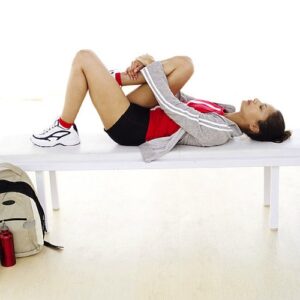Aches & Pains hampering your workout?
 Don’t let aches and pains keep you from your workouts by Katie Sampson, MS, ATC
Don’t let aches and pains keep you from your workouts by Katie Sampson, MS, ATC
I am sure at some point in your workout regimen you have experienced an ache or pain that has taken you to your favorite search engine for a diagnosis and the best treatment (which I wouldn’t necessarily recommend). It is important to keep in mind that general muscle soreness (aka “Delayed Onset Muscle Soreness”) is likely and necessary post-workout for muscle growth. To help recover from each workout session and minimize soreness between workouts, it is important to fuel your body properly; this includes balanced meals as well as hydration. Also, an adequate warm-up and cool-down including stretching helps to circulate nutrient rich blood to working muscles and joints.
As a certified athletic trainer, I work with athletes on a daily basis to keep them physically active, prevent injury and manage orthopedic as well as other medical conditions. Through the years I have picked up on a couple tips and tools to keep an active individual at a productive level of performance.
There are several tools on the market to offer manual therapy to those sore, tight, inflexible muscles including massage sticks and foam rollers. I have found that a medicine ball or soccer ball can offer very similar results depending upon the desired density you are looking for. For a more focal muscle release, you can use a smaller ball (tennis or lacrosse ball). Also, duct taping two tennis balls together can offer a great contoured shape around the spine for rolling out muscle tension in between your shoulder blades, up into your traps or even in your low back area. You can place the duct taped tennis balls on the ground and roll on top of them or for a less intense release, place them between you and a wall and lean against them as your roll up and down.
If you experience arch pain after a long day on your feet or after a run, you can keep a water bottle in the freezer for a nice ice massage. Simply place the frozen water bottle on the floor and either sitting or standing, roll your foot over the bottle for about 5-10 minutes. If you are experiencing arch pain that is worse in the morning, consider seeing a physician as you may have a more severe case of plantar fascitis that needs further attention.
Homemade ice-cups are a great (and quick) way to ice down an area. Using little paper Dixie cups, fill with water and place in freezer. When you are ready to ice, tear off the top rim of the cup so that the ice is exposed and simply rub over the treatment area for about 5-10 minutes. Remember to have a towel handy, as the ice will melt and could make a mess! Also, add pressure for a massage effect. These are great for “shin splints” and “jumper’s knee”. Keep in mind that if your pain persists, consider cross-training to allow proper healing time to the affected area.
Often, there is a fine line between when you should push through the pain or back off. Rarely should you ever ignore what your body is telling you. It is better to address the issue rather than let it persist and get worse, and as always, when in doubt, get it checked out!
 A little bit about Katie: Katie graduated from Boston University with a Masters in Applied Anatomy and Physiology. She currently works for Nazareth College as an athletic trainer.
A little bit about Katie: Katie graduated from Boston University with a Masters in Applied Anatomy and Physiology. She currently works for Nazareth College as an athletic trainer.
